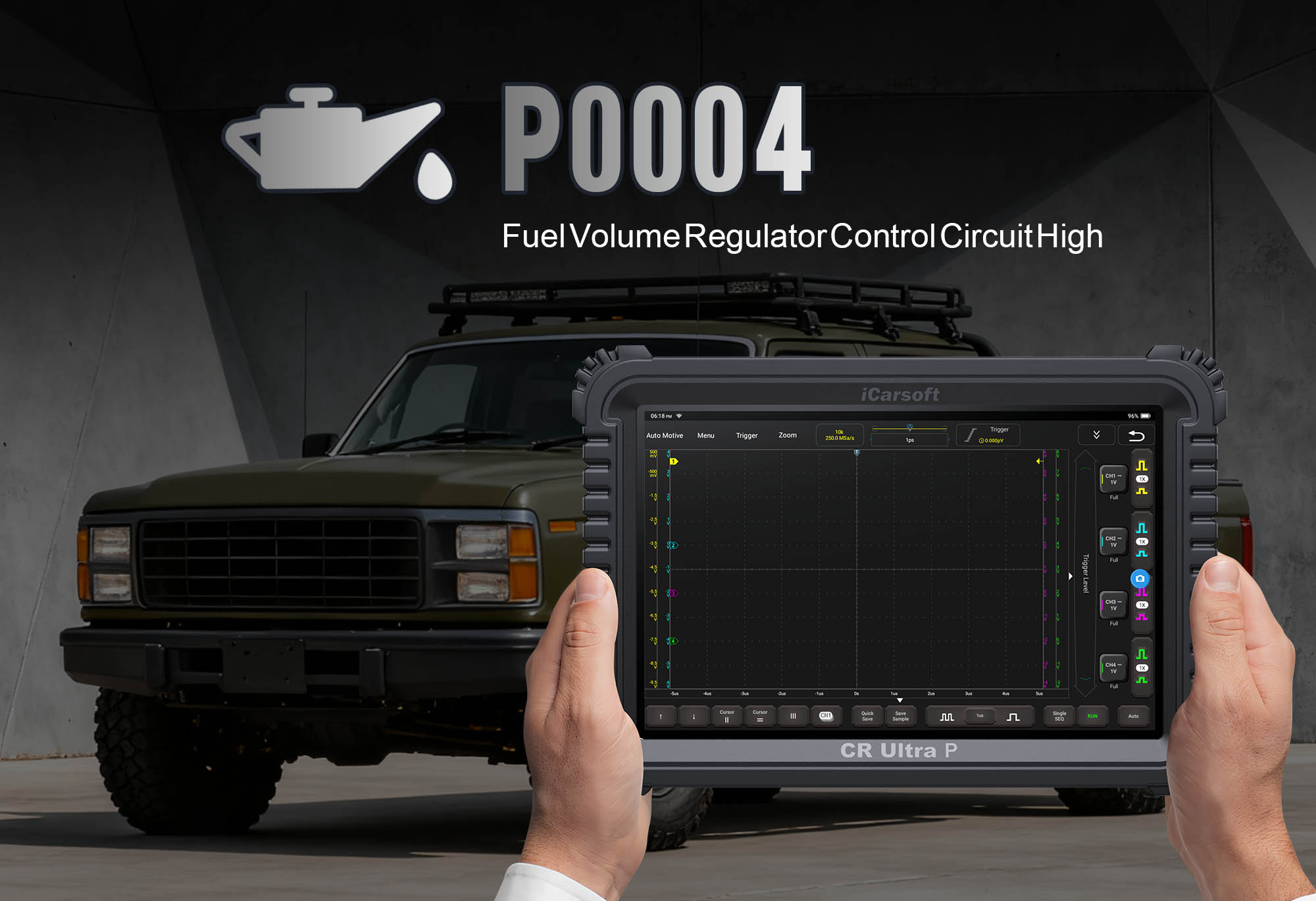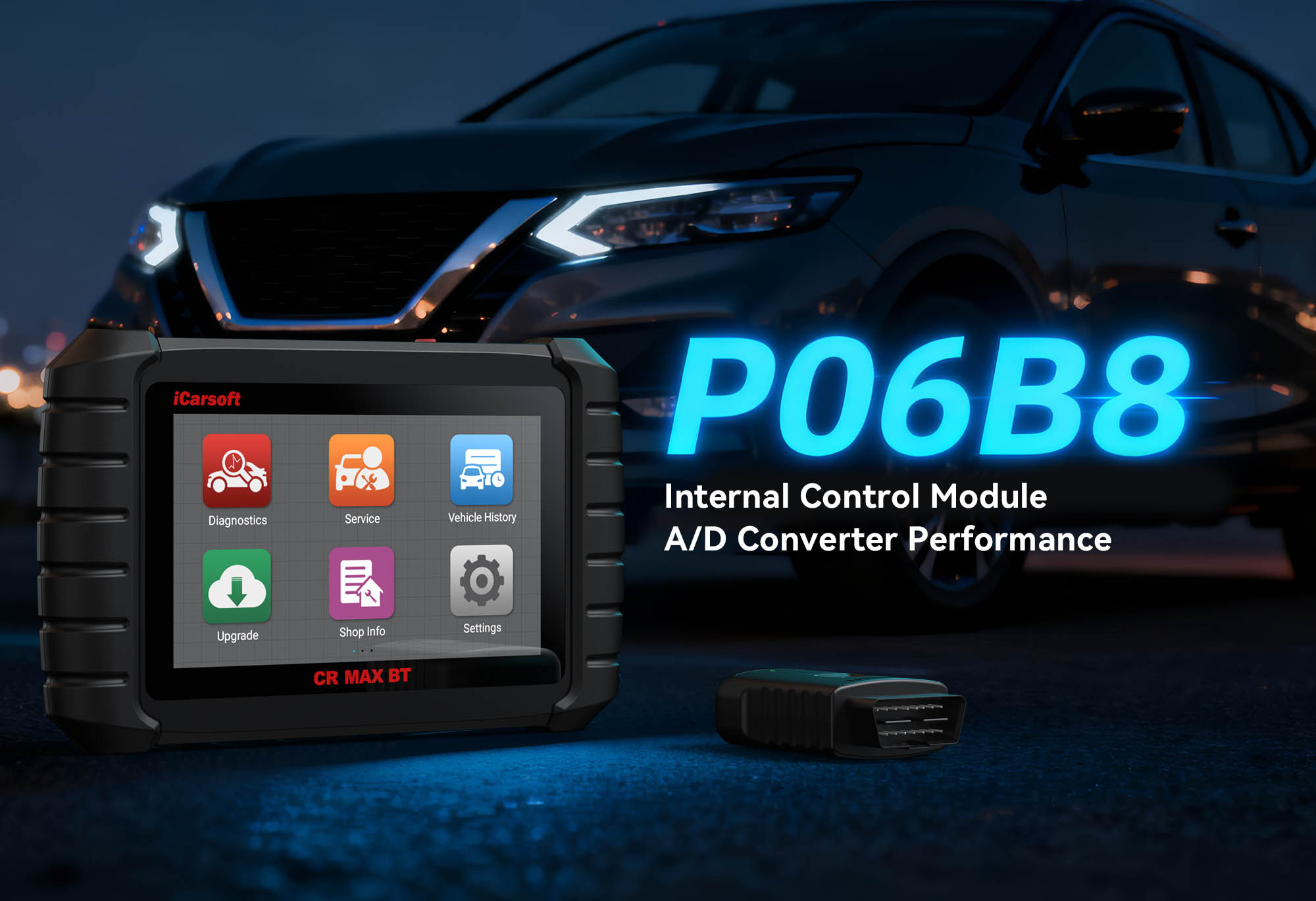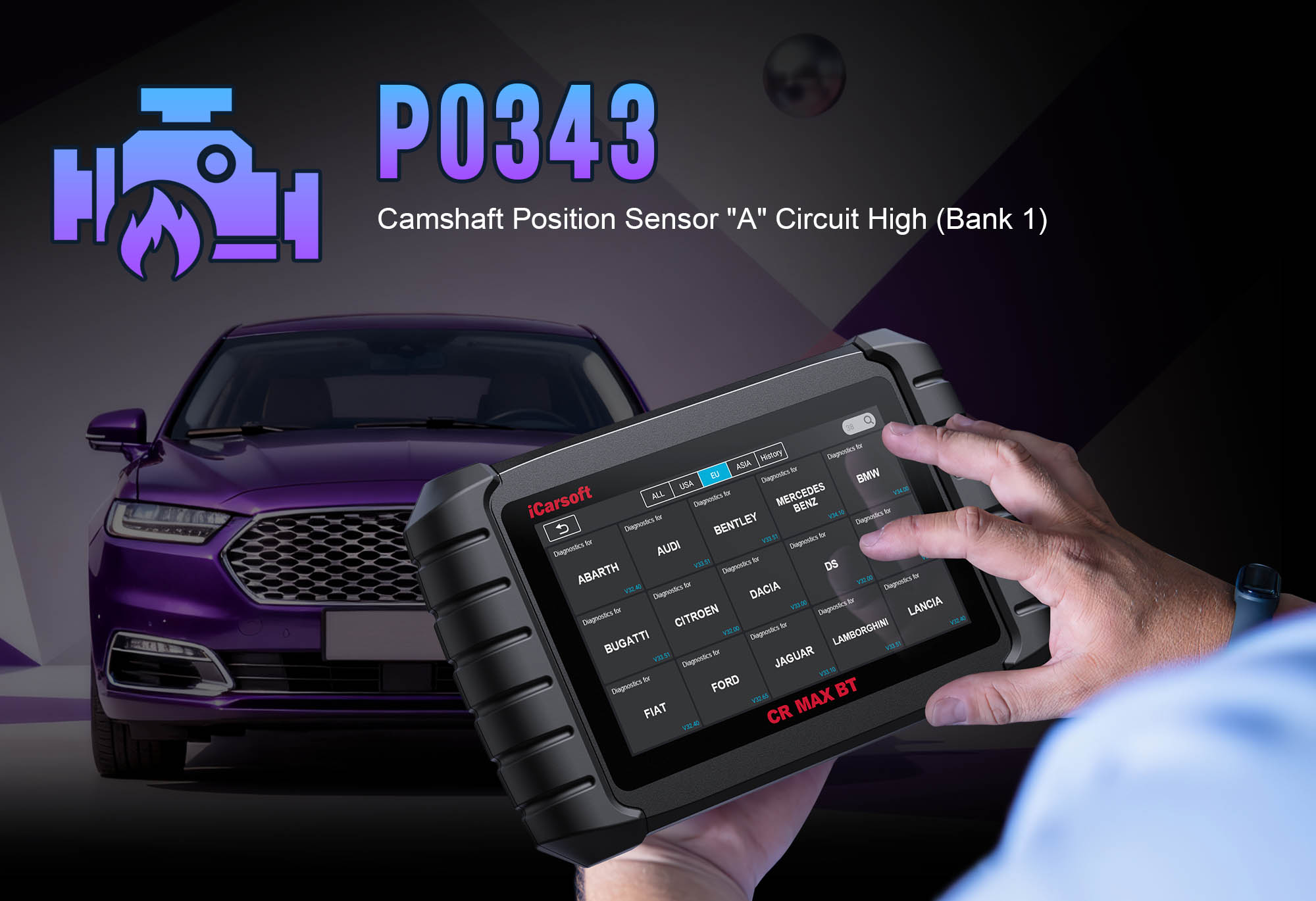Understand & Fix P0004: Fuel Volume Regulator Control Circuit High with iCarsoft CR Ultra P
If your vehicle struggles to start, stalls unexpectedly, or shows a sharp drop in fuel efficiency, a diagnostic scan will likely return P0004. This OBD-II code stands for "Fuel Volume Regulator Control Circuit High"—a critical fault targeting the fuel volume regulator (FVR) and its control circuit. The FVR manages the amount of fuel delivered to the engine’s fuel rail, ensuring consistent pressure for optimal combustion. A "high circuit" error means the Engine Control Module (ECM) detects abnormal voltage in the FVR’s control wiring, disrupting fuel delivery and risking engine damage.
Basic scanners might only flag a "fuel system error" but can’t measure circuit voltage, test regulator responsiveness, or validate wiring integrity—leaving you guessing between a faulty FVR, damaged wires, or a failing ECM. The iCarsoft CR Ultra P, with its OE-level fuel system diagnostics, bi-directional control, and circuit testing tools, solves this. Below, we break down P0004, its causes, symptoms, step-by-step resolution, and 8 FAQs to answer common troubleshooting questions.
What Is P0004?
P0004 focuses on the fuel volume regulator’s control circuit—a component that works with the fuel pump to adjust fuel flow to the fuel rail. The ECM sends a low-voltage signal (typically 5V) to the FVR to regulate fuel volume; when the circuit voltage exceeds the expected range (e.g., spikes to 12V), the ECM triggers P0004. This high voltage often indicates a short circuit, damaged wiring, or a malfunctioning FVR that’s not responding to the ECM’s commands.
Key Symptoms of P0004
-
Illuminated Check Engine Light: The primary warning sign, often paired with codes like P0087 (low fuel pressure) or P0089 (fuel pressure regulator performance).
-
Hard Starting: Insufficient or erratic fuel delivery makes it difficult for the engine to crank.
-
Engine Stalling: Interrupted fuel flow can cause the engine to shut off while driving, especially at idle or low speeds.
-
Poor Fuel Economy: A malfunctioning FVR disrupts fuel pressure, leading to inefficient combustion and increased fuel consumption.
-
Reduced Engine Power: The ECM may enter "limp mode" to protect the engine, limiting acceleration and top speed.
-
Rough Idle: Inconsistent fuel volume causes the engine to shake or vibrate when stationary.
Common Causes of P0004
|
Cause
|
Description
|
|
Faulty Fuel Volume Regulator (FVR)
|
A worn or shorted FVR fails to regulate fuel flow, causing abnormal circuit voltage.
|
|
Wiring/Circuit Issues
|
Frayed wires, corroded connectors, or a short to the vehicle’s 12V power supply in the FVR circuit.
|
|
Blown Fuse or Faulty Relay
|
A damaged fuse or relay in the fuel system disrupts voltage flow to the FVR.
|
|
Fuel Pump Malfunction
|
A failing fuel pump can overwork the FVR, leading to circuit voltage spikes.
|
|
ECM Error
|
Rarely, the ECM’s internal circuit for controlling the FVR malfunctions, sending incorrect voltage signals.
|
Why iCarsoft CR Ultra P Excels at Diagnosing P0004
The CR Ultra P outperforms basic tools with features tailored to fuel system and circuit diagnostics:
Real-Time Circuit Voltage Tracking
Monitors FVR control circuit voltage, highlighting spikes or inconsistencies that trigger P0004.
Bi-Directional FVR Testing
Activates the fuel volume regulator manually to verify responsiveness, distinguishing FVR faults from wiring issues.
Circuit Integrity Checks
Uses built-in multimeter functions to test for shorts, opens, and continuity in the FVR wiring.
Topology Mapping
Visualizes the fuel system’s components and wiring, making damaged connectors or hidden shorts easy to locate.
Global Vehicle Coverage
Supports 200+ passenger vehicle brands (Ford, Toyota, BMW, Audi, etc.) and 2018+ models with advanced fuel systems.
41 Hot Service Functions
Includes fuel system reset, injector coding, and FVR calibration—critical for validating repairs and restoring fuel system performance.
Step-by-Step: Diagnose P0004 with iCarsoft CR Ultra P
-
Confirm P0004 & Gather Data
Plug the CR Ultra P into your vehicle’s OBD-II port, power on the tool, and select AutoVIN Identify to automatically detect your vehicle’s make, model, and year.
Navigate to Engine > Fault Codes > Read Codes to confirm P0004. Tap Code Details for model-specific insights (e.g., "Chevrolet Silverado: Fuel Volume Regulator Control Circuit High; Voltage: 11.8V, Expected: 4.5–5.5V; Check FVR Wiring or Regulator").
-
Analyze Live Fuel System Data
Go to Engine > Live Data > Fuel System and monitor three key metrics:
1. FVR Control Circuit Voltage: Should stay within 4.5–5.5V (OEM specs vary slightly). A reading above 6V confirms the high-circuit issue.
2. Fuel Rail Pressure: Should match your vehicle’s specs (e.g., 40–55 psi at idle). Low pressure = FVR or fuel pump fault.
3. Fuel Pump Duty Cycle: Should adjust with engine load. A stuck duty cycle = pump or FVR malfunction.
-
Test the Fuel Volume Regulator (FVR)
1. Use Bi-Directional Control > Fuel System > FVR Test: Send voltage commands (4.5V to 5.5V) to the FVR. Listen for a faint "click" (regulator activating) and check for fuel pressure changes. No response = faulty FVR.
2. Locate the FVR: Use the CR Ultra P’s Component Location tool (typically on the fuel rail or near the fuel pump).
3. Inspect & Test: Check for corrosion, oil leaks, or loose connections. Use the CR Ultra P’s Resistance Test to check the regulator’s internal windings (should match OEM specs, e.g., 10–20 ohms).
-
Inspect Wiring, Fuses, & Fuel Pump
1. Wiring Check: Use Continuity Test to check FVR wiring for breaks. Look for frayed wires near the FVR, fuel pump, or ECM.
2. Fuse/Relay Check: Navigate to Vehicle > Fuse Box Diagram (via the CR Ultra P) to find fuel system-related fuses/relays. Test for continuity with the tool’s multimeter—replace any blown fuses.
3. Fuel Pump Check: Monitor Fuel Pump Output in the CR Ultra P’s live data. Low output (below specs) = failing fuel pump, which can contribute to P0004.
-
Repair & Clear the Code
- Replace the FVR if tests confirm it’s faulty (use OEM-compatible parts to ensure compatibility).
- Repair damaged wiring, replace blown fuses/relays, or service the fuel pump as needed.
- Use the CR Ultra P to Clear Codes and run a Fuel System Validation Test (under Special Functions) to confirm P0004 is resolved.
FAQs: P0004 Troubleshooting
-
Can I drive with P0004?
Short distances (e.g., to a repair shop) may be possible, but long-term driving risks engine stalling or damage. Use the CR Ultra P to monitor FVR voltage—if it stays above 8V, avoid driving until repairs are done.
-
How much does it cost to fix P0004?
A new fuel volume regulator costs $80–$250, plus $150–$300 for labor. Using the CR Ultra P to diagnose yourself saves on shop diagnostic fees ($100–$150).
-
Why does P0004 keep returning after clearing it?
The root cause wasn’t addressed. Common culprits: unaddressed wiring shorts, a faulty fuel pump relay, or a failing ECM. Use the CR Ultra P’s History Log to track when the code reappears (e.g., after rain = water-damaged wiring).
-
Is P0004 caused by bad fuel?
No—bad fuel typically causes codes related to injector clogs (e.g., P0201) or fuel quality (e.g., P0171). P0004 is strictly a control circuit or FVR issue.
-
How do I distinguish between a faulty FVR and wiring?
Use bi-directional testing: FVR doesn’t activate + normal circuit voltage (4.5–5.5V) = faulty FVR; FVR doesn’t activate + high circuit voltage (>6V) = wiring short or damaged connector.
-
Do I need to calibrate the FVR after replacement?
Yes—use the CR Ultra P’s Fuel Volume Regulator Calibration (under Special Functions) to sync the new FVR with the ECM. This ensures the regulator responds correctly to the ECM’s signals.
-
Can a dead battery cause P0004?
Indirectly—low battery voltage (below 12V) disrupts the ECM’s ability to send accurate signals to the FVR, leading to false high-voltage readings. Use the CR Ultra P’s Battery Tester to check voltage (12.4–12.7V is normal).
-
Will P0004 fail an emissions test?
Yes—erratic fuel delivery disrupts combustion, increasing hydrocarbon and carbon monoxide emissions. Fix P0004 with the CR Ultra P, drive 50+ miles to reset readiness monitors, and retest.
Conclusion
P0004’s fuel volume regulator control circuit high fault threatens engine reliability and fuel efficiency. The iCarsoft CR Ultra P simplifies diagnosis with real-time voltage tracking, bi-directional tests, and system validation, ensuring you fix the root cause—not just the code.
With 200+ brand support, a 10.1-inch HD touchscreen, and 3 years of free software updates, the CR Ultra P is a long-term investment for DIYers and mechanics alike. Resolve P0004, restore smooth engine performance, and drive with confidence—all with one professional-grade diagnostic tool.





